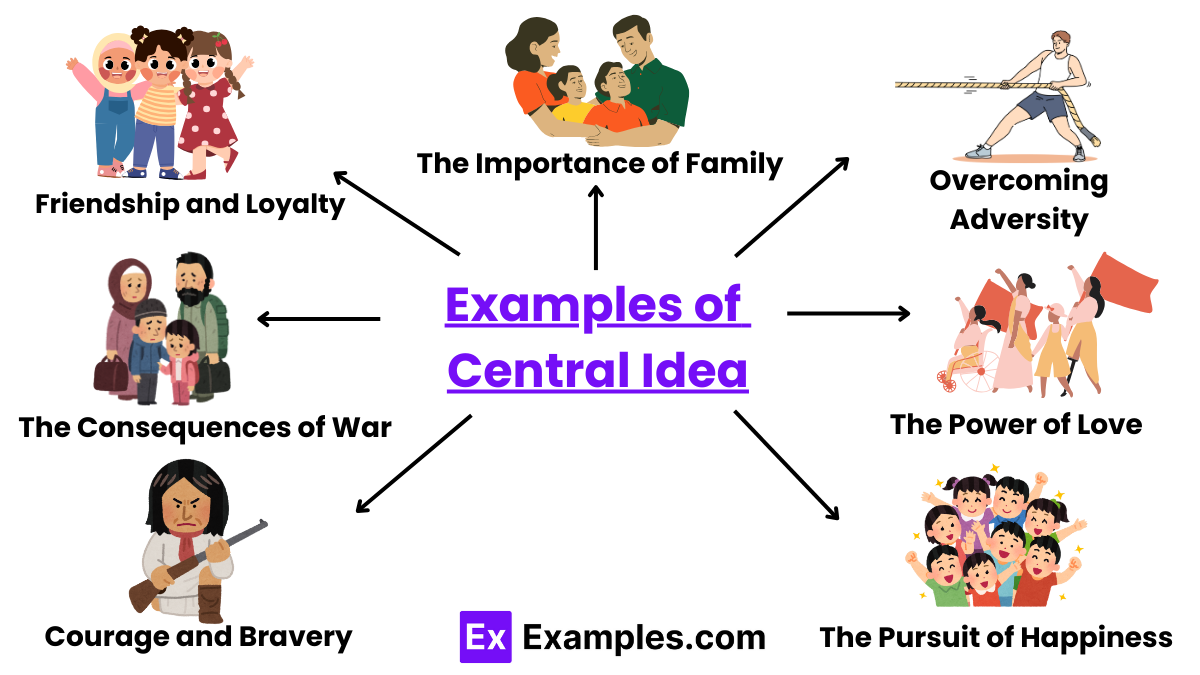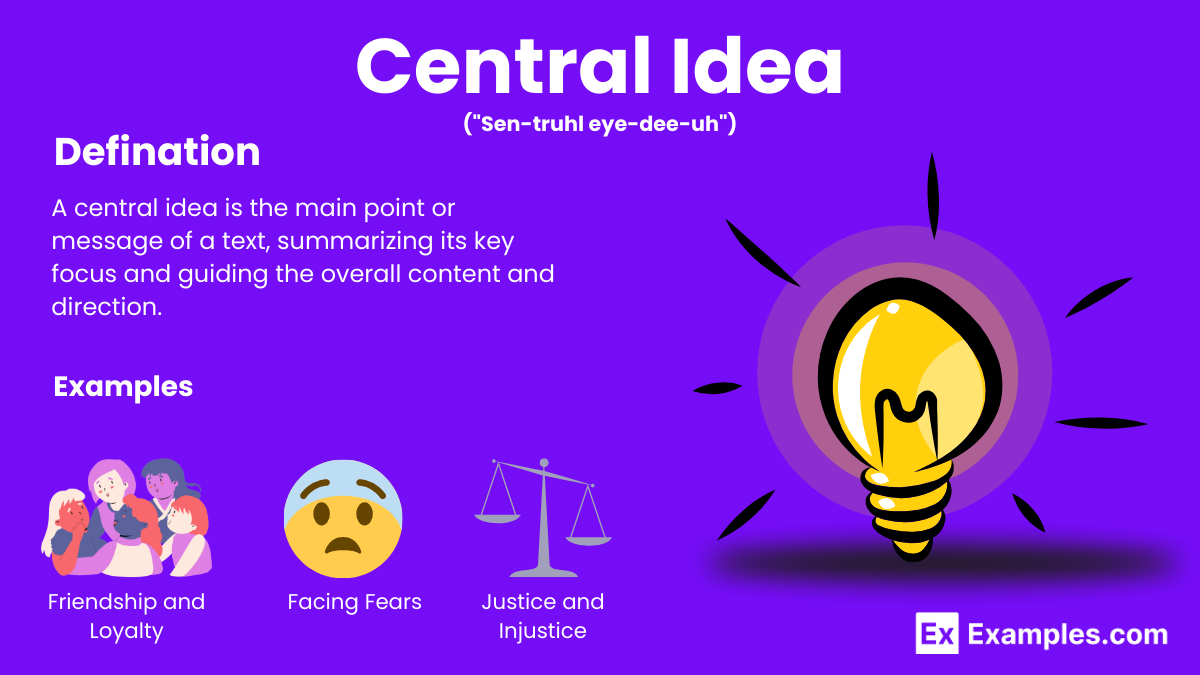25+ Central Idea Examples to Download
The central idea is the main point or the most important concept of a passage or text. It is the primary focus around which the entire content revolves. The central idea is usually expressed in a single sentence that summarizes the key message or the main argument presented. Understanding the central idea helps readers grasp the overall purpose and significance of the text, providing a clear understanding of the author’s intended message or the text’s main theme.
What Is a Central Idea?
A central idea is the main point or primary concept of a text. It encapsulates the essential message or argument the author intends to convey, summarizing the key theme or focus in a concise manner. Understanding it helps in comprehending the text’s overall purpose.
Central Idea Examples

- Friendship and Loyalty
- The Importance of Family
- Overcoming Adversity
- The Power of Love
- The Pursuit of Happiness
- Courage and Bravery
- The Consequences of War
- Justice and Injustice
- The Struggle for Freedom
- Environmental Conservation
- The Dangers of Greed
- The Value of Hard Work
- Personal Growth and Development
- The Impact of Technology
- Cultural Identity and Heritage
- The Role of Education
- Facing Fears
- Survival and Resilience
- The Effects of Poverty
- The Search for Truth
- The Quest for Power
- The Meaning of Life
- The Impact of Racism
- The Benefits of Teamwork
- The Importance of Honesty
- The Consequences of Betrayal
Characteristics Of Central Idea
- Clarity: The central idea should be clear and unambiguous, making it easy for readers to understand the main point.
- Conciseness: It is usually expressed in a single sentence or a brief statement, summarizing the core message of the text.
- Relevance: The central idea is directly related to the main topic or subject of the text, ensuring it addresses the key focus.
- Specificity: It is specific enough to give a clear direction to the content but broad enough to encompass the entire message.
- Significance: The central idea reflects the most important concept or argument, highlighting its significance within the text.
- Supportable: It can be supported by details, evidence, and arguments presented in the text, making it credible and convincing.
- Universal: While specific to the text, a central idea often touches on universal themes or messages that resonate with a wide audience.
- Unifying: It acts as a unifying element, tying together all the details, examples, and arguments presented in the text.
- Focused: The central idea maintains a clear focus, avoiding unnecessary digressions or unrelated subtopics.
- Implicit or Explicit: It can be explicitly stated within the text or implicitly understood through the content and context.
Why is it important to identify central ideas?
Identifying central ideas is crucial because it helps readers understand the main message or purpose of a text, facilitating better comprehension and retention. It allows for efficient summarization and synthesis of information, enabling readers to grasp the essence of complex materials quickly. Recognizing central ideas aids in critical thinking, as it encourages readers to evaluate and interpret the underlying themes and arguments. Additionally, it supports effective communication by ensuring that the key points are conveyed clearly and persuasively.
Four-Step Process to Identify Central Idea
- Read and Understand the Text: Read the entire text carefully to gain a thorough understanding of the content. Pay attention to the title, headings, and any emphasized points. Take notes on key details and main points.
- Identify the Topic: Determine the main subject or topic of the text. Ask yourself, “What is this text about?” This step helps in narrowing down the general focus of the content.
- Look for Repeated Ideas: Look for ideas, phrases, or concepts that are repeated throughout the text. These often indicate what the author considers important and can lead you to the central idea.
- Summarize the Main Point: Summarize the main point or message of the text in one or two sentences. Ensure your summary captures the essence of the text without including unnecessary details. This summary is the central idea.
The Significance of the Central Idea in Modern Business
The central idea in modern business serves as the cornerstone of strategic planning and decision-making. It provides a clear and focused direction for the company, ensuring that all efforts align with the overarching goals. By identifying and articulating the central idea, businesses can effectively communicate their mission and vision to employees, stakeholders, and customers, fostering a cohesive and motivated workforce. It aids in differentiating the business from competitors, highlighting its unique value proposition. Furthermore, a well-defined central idea helps in prioritizing resources and initiatives, driving innovation, and maintaining consistency in branding and messaging. In an ever-evolving market, the central idea anchors the business, guiding it through challenges and opportunities, and ensuring long-term sustainability and success.
Difference Between Central Idea and Theme
| Aspect | Central Idea | Theme |
|---|---|---|
| Definition | The main point or primary message of a text. | The underlying message or the universal lesson conveyed. |
| Focus | Summarizes what the text is about. | Explores broader concepts and life lessons beyond the text. |
| Scope | Specific to the text and its content. | More general, can apply to various texts and contexts. |
| Expression | Often explicitly stated in the text. | Often implicitly conveyed through characters, plot, and setting. |
| Purpose | Provides a concise summary of the text’s key message. | Offers deeper insights into human nature, society, and morals. |
| Example | Central idea of “To Kill a Mockingbird” could be racism in the American South. | Theme of “To Kill a Mockingbird” includes the moral nature of human beings. |
| Identification | Found by looking at main points and repeated ideas. | Identified through analysis of symbols, motifs, and recurring elements. |
| Relevance | Directly related to the author’s main argument or focus. | Related to broader philosophical or moral questions. |
| Length | Usually one sentence or a brief statement. | Can be longer, encompassing various elements of the story. |
| Usage | Helps in summarizing and understanding the text’s purpose. | Helps in interpreting and finding deeper meaning in the text. |
How is the central idea different from the theme?
The central idea is the main point of the text, while the theme is the underlying message or lesson conveyed.
Why is identifying the central idea important?
It helps in understanding the main message, facilitating better comprehension and retention of the text.
Where is the central idea usually found?
It can be found in the introduction, conclusion, or repeated throughout the text.
How do you identify the central idea?
Read the text carefully, identify the main topic, look for repeated ideas, and summarize the main point.
Can a text have more than one central idea?
Yes, especially in longer or more complex texts, multiple central ideas can be present.
What is the difference between the central idea and the main idea?
They are often used interchangeably, but the central idea is typically more specific and concise.
How does the central idea help in summarizing a text?
It provides a concise summary of the text’s key message, making it easier to understand the overall purpose.
Is the central idea always explicitly stated?
No, sometimes it is implied and needs to be inferred from the context and details.
What role does the central idea play in writing?
It guides the content, ensuring that all parts of the text align with the main message.
Can the central idea change throughout the text?
Generally, the central idea remains consistent, but the focus can shift as the text develops.


